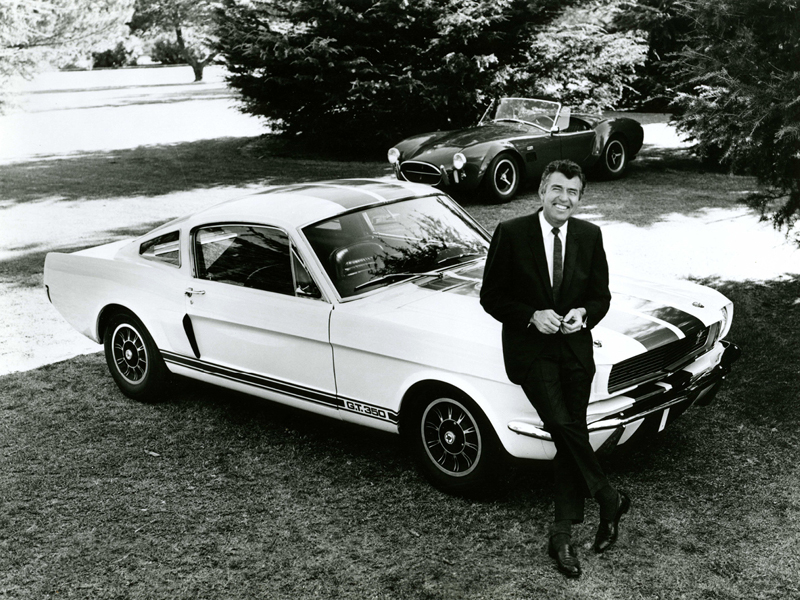By LouAnn Campbell and Steve Freeman
The name Carroll Shelby is hardly recognized by most East Texans, but the Shelby name is admired far, far beyond the region that gave him his start.
Just using the word “Shelby” conjures up images to many of classic sports car designs, racing championships, 5,000-plus member car clubs, car museums in Las Vegas, Nevada, and Boulder, Colorado, and memorabilia for sale up to hundreds of thousands of dollars on eBay and elsewhere.
The son of a rural Texas mailman, Carroll Shelby went on to acclaim as, first, a celebrated race car driver, and then designer of one of the most famous American performance race cars — the legendary Shelby Cobra sports car, which also influenced his designs of versions of Chrysler Viper and the ever-popular Ford Mustang. The Los Angeles Times called him a “cult classic car designer.”
But there is so much more to the man, the proud Texan, who became an iconic figure in 20th century America. The larger-than-life entrepreneur created an auto parts and design-licensing empire, appeared twice on the cover of Sports Illustrated magazine as “Driver of the Year,” and helped found the famed Terlingua International Chili Championship. His “Carroll Shelby’s Original Texas Brand Chili” is still available on grocery shelves.
“I like to get into things other people are not in, to see if I can make it work,” he once said.
All the while, Shelby achieved notoriety by being named to both the international and national motor sports halls of fame. And since art imitates life, Hot Wheels® cars produced 11 toy car designs in his honor, the most recent being the 1968 Ford Mustang Shelby GT500.
Even after his death at age 89 in 2012, the legacy of Carroll Shelby lives on in his family, in Shelby Corporation, in his children’s health and education foundation, and in East Texas. It’s there that he was born, is buried, and there that his scholarship program at Northeast Texas Community College (NTCC) still trains and certifies auto mechanics.
A Texas Original
From humble beginnings, Carroll made his way in life with the lessons learned during the great depression era. Born in Leesburg between Winnsboro and Pittsburg on January 11, 1923, he grew up and learned the value of hard work and developed a passion for airplanes and racing cars.
As a young adult, he followed his interest in flying by joining the U.S. Army Air Corp, becoming a sergeant. He was first stationed at Lackland Air Field and in Wichita Falls as an instructor pilot.
“He probably loved airplanes more than cars; a lot of people don’t know that,” said Aaron Shelby, grandson of the late Carroll Shelby. “His stories about flying are comical. He would drop love letters to my grandmother (Jeanne Fields) who was home on the farm near Dallas.”
After World War II, Shelby attempted various odd jobs — a trucker, oil driller, and chicken farmer — but nothing suited him, nothing brought him passion, as much as his memories of speed — either flying or driving. He went on to racing champion and car design fame, but his roots were deeply embedded in East Texas.
“I think East Texas was Carroll’s heritage. And for me that’s my family’s heritage. It will always hold a dear place in our hearts,” Aaron said.
Shelby owned a variety of ranches in Northeast Texas with miniature horses and African cattle while keeping his hand in high-performance design into his later years.
He was buried in his hometown of Leesburg, but not before he inaugurated scholarships for student auto mechanics at NTCC that actually saved the program.
The Carroll Shelby Automotive School at NTCC began over a meal between Shelby and the college’s vice president, Dr. Jon McCullough, in 2007. Shelby found out the college had a culinary program and he and his new friend, Jon, would partake of the chef’s food. The conversation naturally steered to auto mechanics and when Shelby found out the program was too expensive for most East Texas kids to pursue and that a gift of $50,000 in scholarships would help 18 to 20 students, his decision was definitive.
“All he said was ‘done!’” McCullough said.
The sports car legend had a heart for guys who grew up in East Texas and just needed a chance to succeed, he added. Shelby’s foundation became annual benefactors and its chief made occasional trips to the campus to meet and talk with students, who loved his life stories.
From the six students enrolled prior to that, the program has 53 this year. Shelby also chipped in one-quarter of a million for equipment, tools, and machinery.
The Starting Line
It was in 1952, just short of his 30th birthday, that Shelby got into a race car for the first time and won a race in Norman, Oklahoma. He drove a little MG. Realizing that he was pretty good at racing cars, the victory changed the course of his life. He surrounded himself with good people and became an accomplished race car driver.
He won four races in borrowed cars before the Aston Martin sports car team noticed and added him to their team to race throughout the world. He raced MGs, Cadillacs, Ferraris, Maseratis, and Aston Martins on the most famous speedways in the world.
While arguably one of the most famous race car drivers of all time, his greatest moment was winning LeMans 24-hour Race in an Aston Martin DBR1/300 in 1959.
Shelby’s personality, good looks, driving expertise, and trademark striped overalls enhanced his popularity. But his health presented problems that would take him out of racing for good.
In February 1960, Shelby experienced chest pains and doctors eventually diagnosed it as “angina pectoralis,” in which the coronary arteries are starved for blood. In December, Shelby competed in his last race and won the USAC driving championship for 1960.
Shelby was told that if he didn’t stop and take care of himself, he may see the same fate as his father, who had died of heart disease. He wasn’t sure what to do next after eight years of racing cars. However, he did own a small sports car dealership in Dallas.
Meeting Chrysler Corporation’s Lee Iacocca and some people from the Ford Motor Company through racing would prove to be the connections Carroll needed in order to begin building and designing race cars.
“He basically hounded them for about a year,” Aaron said.
When Carroll was in England, he saw the AC Ace Car, a little English sports car with a small motor in it. He felt that if he could get some money and some of Iacocca’s V-8 engines, he could make something out of them. Iacocca was known to say they finally gave it to him so that he would stop bothering him.
The year the first Cobra came out was 1962. Model 260 was a little Cobra which led into the 289.
“With bailing wire and duct tape, he got the whole thing put together,” Aaron said.
Only one Cobra was produced first because Carroll didn’t have the money for more. He was able, however, to get every car magazine in the country to test the car.
“For every test he would paint the car a different color so they all thought there were a handful of these cars out there.”
The first Cobra is still part of the Carroll Shelby estate. The car is on display in the Shelby American Museum in Las Vegas.
The Cobra’s development and acceptance led into the rest of his admired design and production. It got him back into the racing world, which he really enjoyed. It also resulted in the formation of the Shelby American Racing Team and the arrival of the bigger 427 Cobra. That is what led to Ford wanting his help with the Mustang.
Naming the Mustang GT 350 was simple. At the factory in Los Angeles, there were two buildings and it took Carroll 350 steps to go between the buildings.
According to Aaron, “The GT part was pretty easy —‘Grand Touring’ — since it was going to be a race car. A lot of people think the 350 equated to the engine. It was close to the engine size, but not quite. It was really walking off the 350 steps between the two buildings.”
Mustang was well on the way to becoming iconic and Shelby’s influence in turning out muscle car varieties garnered more success for the East Texan. By some estimations, Shelby’s high performance designs resulted in some 14,000 Mustangs and 1,000 Cobras produced and sold since then.
Non-Stop Legacy
Today, Shelby’s companies are engaged in the manufacturing and marketing of performance vehicles and related accessories worldwide, as well as the licensing of the Shelby brand to third parties in connection with various products, including vehicles, memorabilia, video games, models, toys, branded apparel, styling, and performance parts.
Shelby American employs 125 in Las Vegas and produces seven to 10 vehicles a week. The last super-car Shelby conceived, the Shelby 1000, is a $210,000 Mustang that can hit 200 mph.
With his extensive business dealings set, Shelby took on some philanthropic endeavors and side business-type hobbies in his senior years.
The Carroll Shelby Children’s Foundation was set up after he had his heart transplant in 1990. Shelby was one of the nation’s longest-living heart transplant recipients and was also a kidney transplant recipient. His health care needs opened his eyes to others.
The foundation is dedicated to providing financial support for children and medical professionals to help overcome life-threatening health issues worldwide, in addition to its commitment to education. The foundation has helped numerous youngsters undergo major coronary surgeries and provided seed monies to launch health care programs and facilities. Organizations conducting research in coronary and organ transplant management also receive grant money from the foundation.
The fact that Shelby’s life was filled with diverse interests — hot rods to health care and education — only illustrates his Texas-sized personality.
“He could relate to anyone,” said Aaron of his grandfather. “He could associate with anyone and that’s what I hear the most today is what people tell me about meeting him. It was like you were talking to a friend. It didn’t matter if you were talking about cars or cows or airplanes or medical stuff. You just felt like you were just having a conversation with a friend of yours. It takes a special personality to be able to do that.”
While perhaps not original with him, the East Texas native lived by a mantra he quoted often. Shelby once famously looked into a camera during an interview and summed his life up succinctly:
“Yesterday’s history. Tomorrow’s a mystery. So live for today.”


